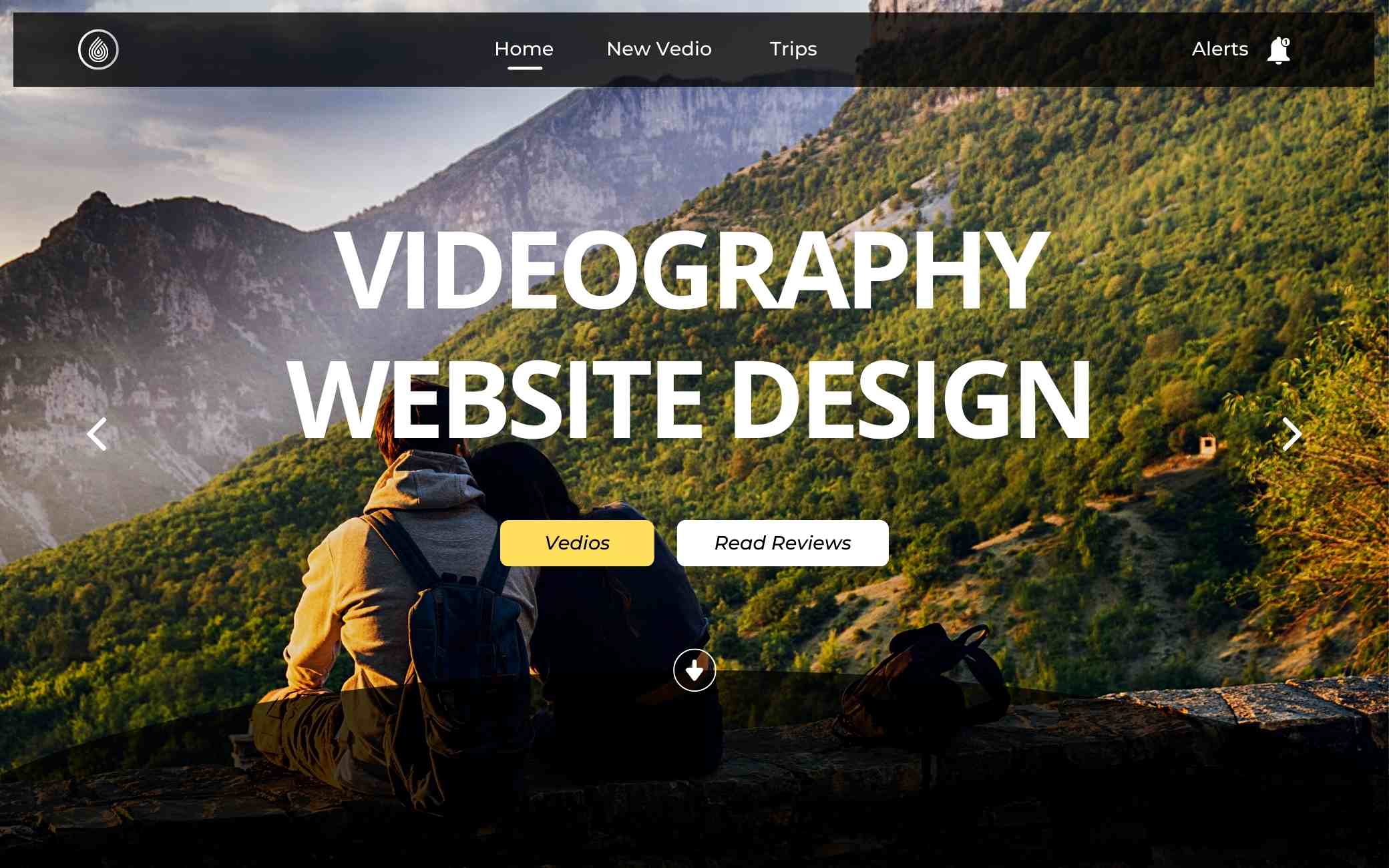Videography Website Design: Tips and Strategies

Creating a Stunning Videography Website Design – In today’s digital age, the demand for high-quality video content is ever-growing, and videographers are in high demand for various events and projects. Whether you’re a professional videographer or just passionate about creating compelling video content, having a well-designed website is crucial for showcasing your portfolio, attracting clients, and establishing your online presence.
Creating a Stunning Videography Website Design
In this comprehensive guide, we will delve into the world of videography website design, providing you with valuable insights and actionable tips to help you create a stunning, user-friendly, and search-engine-friendly website.
Videography Website Design
Table of Contents: Videography Website Design
1. Why Do You Need a Videography Website?
2. Understanding the Essentials of Website Design
3. The Best Platforms for Building a Videography Website
4. Key Elements of an Effective Videography Website
- 4.1. Portfolio Showcase
- 4.2. About Page
- 4.3. Services
- 4.4. Testimonials and Reviews
- 4.5. Contact Information
- 4.6. Blog and Content
5. Designing for User Experience
- 5.1. Navigation and Layout
- 5.2. Responsive Design
- 5.3. Loading Speed
6. Search Engine Optimization (SEO) for Videography Websites
7. Social Media Integration
8. E-commerce Integration
9. Ensuring Security and Data Protection
10. Promoting Your Videography Website
11. Conclusion
1. Why Do You Need a Videography Website?
Before diving into the intricacies of website design, it’s essential to understand why having a videography website is crucial for your business or personal brand. Here are some compelling reasons:
Online Presence:
- In today’s digital world, your online presence is often the first impression potential clients or viewers have of your work. A professional website establishes credibility and showcases your skills and portfolio.
Portfolio Showcase:
- Your website serves as a digital portfolio where you can display your best work. This can significantly impact potential clients’ decisions, as they can see the quality and style of your videos.
Attracting Clients:
- A well-designed website can help you attract new clients and inquiries. It allows you to showcase your services, pricing, and contact information, making it easy for potential clients to get in touch with you.
Personal Branding:
- Your website is a platform to establish and reinforce your personal brand as a videographer. You can convey your unique style, personality, and expertise through the design and content of your site.
Control and Ownership:
- Having your website gives you full control and ownership of your online presence. You’re not dependent on third-party platforms, and you can make changes and updates as needed.
SEO Benefits:
- A well-optimized website can rank higher in search engine results, increasing your online visibility and attracting more organic traffic.
2. Understanding the Essentials of Website Design
Effective website design goes beyond aesthetics; it encompasses usability, functionality, and user experience. Here are some key aspects to consider when designing your videography website:
Aesthetics:
- Your website’s visual appeal plays a significant role in engaging visitors. Choose a design that aligns with your brand and complements your style as a videographer. Use high-quality images and videos to showcase your work.
Usability:
- Ensure that your website is easy to navigate. Visitors should be able to find the information they need without confusion. Clear menus, intuitive buttons, and well-organized content are essential.
Functionality:
- Your website should work seamlessly across different devices and browsers. It should load quickly and offer a smooth user experience. Functionality also includes features like contact forms, search bars, and video playback.
Content:
- High-quality content is key. Write compelling and informative text that complements your videos. Use a mix of written content, images, and videos to engage your audience.
Branding:
- Consistency in branding is essential. Use your logo, color scheme, and typography consistently throughout your website to reinforce your brand identity.
User Experience:
- Prioritize the user experience. Visitors should be able to access your portfolio, learn about your services, and contact you with ease. A positive user experience can lead to higher conversion rates.
Calls to Action:
- Encourage visitors to take action, such as contacting you, booking your services, or subscribing to your newsletter. Use clear and strategically placed calls to action (CTAs) throughout your site.
3. The Best Platforms for Building a Videography Website
Choosing the right platform for building your videography website is a critical decision. There are several options available, each with its own set of features and advantages. Here are some of the best platforms to consider:
WordPress:
- WordPress is a highly versatile and popular content management system (CMS). It offers a wide range of themes and plugins tailored to videographers. With its user-friendly interface, you can create a professional website even if you have limited web design experience.
Squarespace:
- Squarespace is known for its stunning, responsive templates, making it an excellent choice for videographers looking for a visually appealing website. It offers easy customization options and integrated e-commerce features.
Wix:
- Wix is a user-friendly website builder with a drag-and-drop interface. It’s suitable for beginners and offers a variety of templates tailored to videographers. Wix also provides e-commerce capabilities for selling your videos or services.
Weebly:
- Weebly is another user-friendly website builder, with a selection of templates suitable for videographers. It offers features like a drag-and-drop builder, e-commerce options, and integrated marketing tools.
Bespoke Development:
- If you have specific design requirements and want complete control over your website’s functionality, you can opt for custom development. This involves hiring a web developer or agency to create a unique website from scratch.
When choosing a platform, consider your technical skills, budget, and long-term goals. The platforms mentioned above are beginner-friendly, but they may have limitations in terms of customization compared to a custom-built website.
4. Key Elements of an Effective Videography Website
To create a successful videography website, you must include specific key elements that showcase your skills and attract potential clients. Here are the essential components your website should have:
4.1. Portfolio Showcase:
Your portfolio is the heart of your videography website. It’s where you display your best work and demonstrate your skills and style. Consider the following tips:
- Categorization: Organize your portfolio into categories, such as weddings, corporate events, documentaries, or personal projects. This makes it easier for visitors to find relevant examples of your work.
- Video Thumbnails: Use high-quality video thumbnails that provide a glimpse of the content. Make sure they accurately represent the video’s quality and style.
- Detailed Descriptions: Include descriptions for each video, explaining the project, your role, and any unique challenges you overcame.
- Embed Videos: Embed your videos from platforms like YouTube or Vimeo to ensure smooth playback and faster load times.
- Client Logos: If you’ve worked with notable clients or brands, consider displaying their logos or testimonials to build credibility.
4.2. About Page:
The “About” page allows you to introduce yourself to your audience. It’s an opportunity to share your story, experience, and what sets you apart from other videographers. Consider including:
- Your Story: Share your journey as a videographer, your passion for the craft, and what drives you in your work.
- Professional Background: Highlight your experience, education, and any awards or recognitions.
- Personal Touch: Share personal anecdotes or hobbies that can connect you with your audience on a more human level.
- Photos or Videos of Yourself: Adding images or videos of yourself working on a project can make your About page more engaging.
4.3. Services:
Clearly outline the services you offer. Whether it’s wedding videography, event coverage, commercial projects, or video editing services, make it easy for potential clients to understand what you provide. Include:
- Service Descriptions: Explain each service in detail, including what’s included, pricing models, and any packages you offer.
- FAQs: Anticipate common questions clients might have and address them in a FAQ section.
- Testimonials: If you have received positive feedback from previous clients, showcase these testimonials to build trust.
4.4. Testimonials and Reviews:
Testimonials and reviews play a vital role in building trust and credibility. They act as social proof for your skills and reliability. Ensure they are prominently displayed on your website:
- Diverse Testimonials: Show a range of testimonials from different types of clients to appeal to a broader audience.
- Visual Testimonials: If possible, include video testimonials, as they can be more engaging and authentic.
4.5. Contact Information:
Make it easy for potential clients to get in touch with you. Ensure that your contact information is easily accessible:
- Contact Form: Provide a contact form on your website for visitors to send inquiries directly to your email.
- Phone Number and Email: Display your contact information prominently, including your phone number and professional email address.
- Social Media Links: Include links to your social media profiles, allowing visitors to connect with you on various platforms.
4.6. Blog and Content:
Maintaining a blog or creating regular content can benefit your website in multiple ways:
- SEO Boost: Regularly publishing content relevant to your niche can improve your website’s search engine ranking.
- Showcasing Expertise: Writing about video techniques, industry trends, or behind-the-scenes insights can showcase your expertise.
- Engaging Audience: Content that educates, entertains, or informs your audience can keep them coming back to your website.
5. Designing for User Experience
The user experience (UX) of your website is critical for keeping visitors engaged and converting them into clients. Here are some key aspects to consider for an optimal user experience:
5.1. Navigation and Layout:
A clear and intuitive navigation system is crucial. Here’s how you can improve navigation:
- Clear Menu Structure: Organize your menu items logically, making it easy for visitors to find what they’re looking for.
- Search Functionality: Implement a search bar to allow users to find specific content quickly.
- Breadcrumb Navigation: Breadcrumbs can help users understand their location within your site and navigate back easily.
5.2. Responsive Design:
With the increasing use of mobile devices, having a responsive design is a must:
- Mobile Optimization: Ensure your website looks and functions well on various devices, including smartphones and tablets.
- Adaptive Images and Videos: Optimize images and videos for different screen sizes to maintain quality and loading times.
5.3. Loading Speed:
A fast-loading website is crucial for user experience and SEO:
- Image and Video Optimization: Compress images and videos without compromising quality to improve load times.
- Caching and Content Delivery Networks (CDNs): Implement caching techniques and CDNs to enhance the speed of content delivery.
6. Search Engine Optimization (SEO) for Videography Websites
A well-optimized website can significantly impact its visibility on search engines, attracting organic traffic and potential clients. Here are some key SEO strategies for your videography website:
6.1. Keyword Research:
- Conduct thorough keyword research to identify the terms and phrases potential clients might use to find a videographer. Use tools like
- Google Keyword Planner or SEMrush to discover relevant keywords.
6.2. On-Page SEO:
Optimize various on-page elements to improve your website’s search engine ranking:
- Meta Tags: Write compelling meta titles and descriptions for each page, including relevant keywords.
- Image and Video Optimization: Use descriptive file names and alt text for images and videos to help search engines understand their content.
- Structured Data Markup: Implement structured data to provide search engines with more context about your content.
6.3. Off-Page SEO:
Enhance your off-page SEO efforts to improve your website’s authority and credibility:
- Backlink Building: Acquire quality backlinks from reputable websites within the videography or related industries.
- Social Signals: Engage with your audience on social media platforms, as social signals can indirectly impact your SEO.
7. Social Media Integration
Integrating social media into your website can expand your reach and engagement. Here’s how you can effectively integrate social media:
Social Sharing Buttons:
- Enable sharing buttons on your video content to encourage viewers to share your work on their social networks.
Social Media Feeds:
- Display feeds from your social media profiles to keep visitors updated with your latest posts and activities.
Embedded Videos:
- Share your videos directly from your website to social media platforms to increase visibility and engagement.
8. E-commerce Integration
If you offer video packages, courses, or other products, integrating e-commerce functionality into your website can be beneficial. Here are some e-commerce integration tips:
Product Pages:
- Create dedicated pages for each product or service you offer, providing detailed descriptions and pricing information.
Secure Payment Gateways:
- Implement secure payment gateways to ensure safe and convenient transactions for your clients.
Subscription Models:
- Offer subscription-based services or packages for clients looking for ongoing video services.
9. Ensuring Security and Data Protection
Security is crucial for both you and your clients. Ensure the following measures for security and data protection:
SSL Certificate:
- Implement an SSL certificate to secure data transmitted between your website and users.
Regular Backups:
- Back up your website regularly to prevent data loss in case of technical issues or cyber threats.
Privacy Policy and Terms of Service:
- Clearly state your policies regarding data collection, usage, and protection to build trust with your visitors.
10. Promoting Your Videography Website
After creating your website, promoting it effectively is key to attracting visitors and clients:
Content Marketing:
- Create valuable content that attracts your target audience, such as tutorials, behind-the-scenes videos, or industry insights.
Email Marketing:
- Build an email list and send newsletters or updates to subscribers, promoting your services or new content.
Networking:
- Connect with other professionals in the industry, attend events, and engage in partnerships to broaden your reach.
11. Conclusion: Videography Website Design
Creating a successful videography website requires a blend of creative design, technical finesse, and user-centric approaches. By integrating visual aesthetics, user experience, and technical optimization, videographers can create a compelling online platform to showcase their work and attract potential clients. Remember, a well-designed website not only represents your brand but also serves as a powerful marketing tool in the competitive world of videography.
As the demand for video content continues to surge, mastering the art of videography website design becomes an essential skill for professionals in this field. By following the insights and best practices outlined in this guide, videographers can build a strong online presence and stand out in a visually-driven industry.
Recommended Posts

Local SEO vs. Global SEO: A Comprehensive Guide
May 14, 2025



